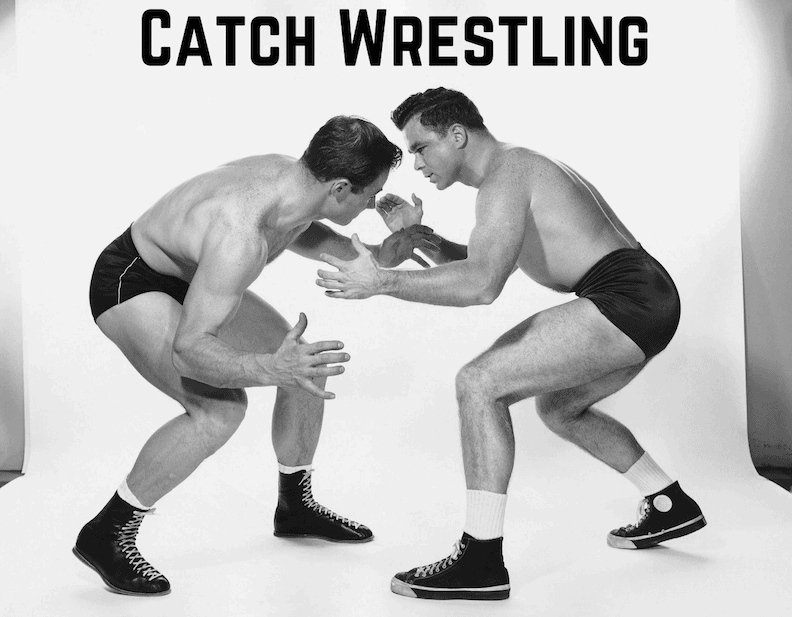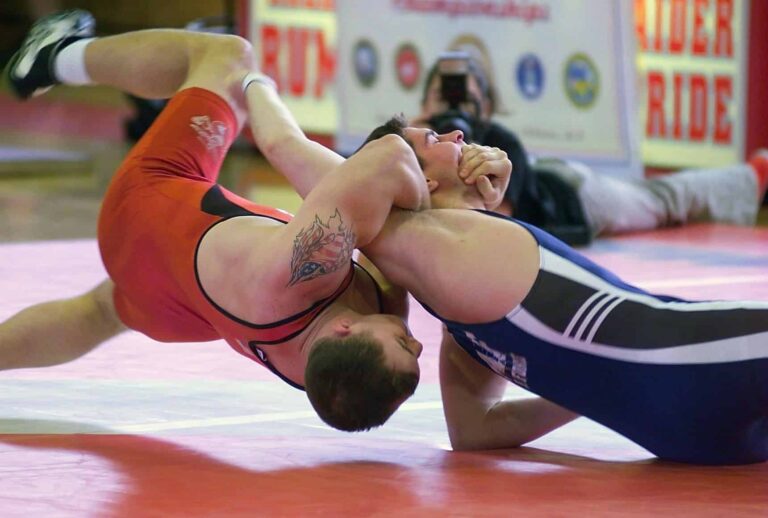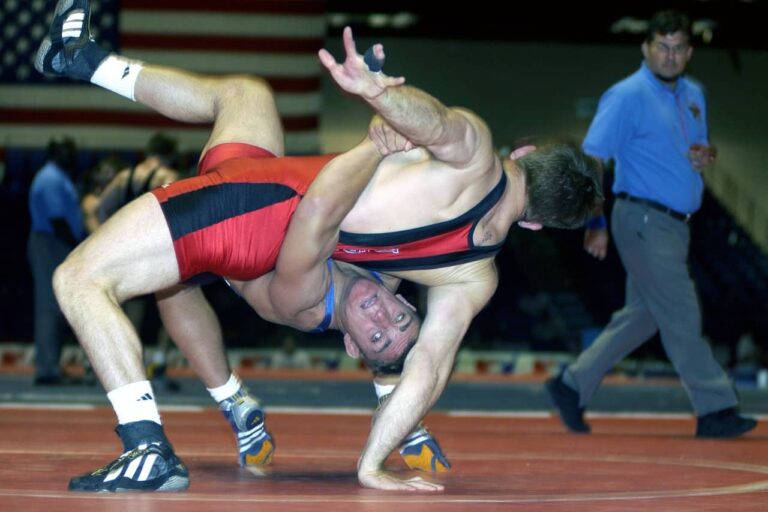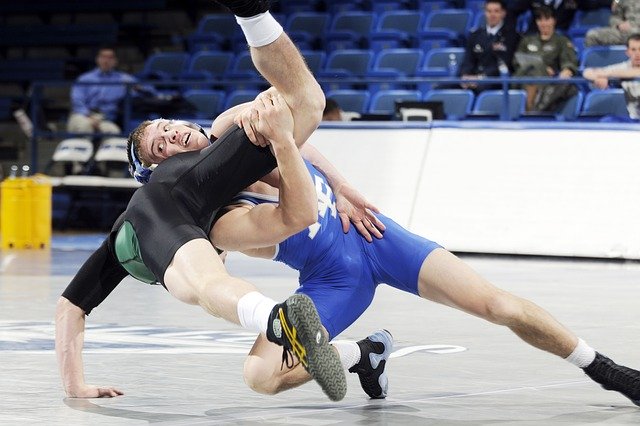Catch Wrestling ( What It Is and How To Get Started )

With the rise of submission grappling such as the ADCC World Wrestling Championship, catch wrestling is starting to become more and more popular. Though catch wrestling has been around for a long time, there are still many people who don’t know what it is.
Catch wrestling is a grappling art popularized by John Graham Chambers in the late 1800s. It is also widely accepted as the parent art of folkstyle and freestyle wrestling. Catch wrestling contains takedowns, pins, and submissions.
Today catch wrestling is not as popular as it once was, however, it does seem to be picking up steam again. As MMA and competitive grappling is becoming more popular many people are starting to look back into this amazing grappling art.
After all, many MMA stars and even UFC champions have come from a background in catch wrestling. In addition, many are looking to catch wrestling to help improve their no-gi grappling game. This grappling art has so much to offer to the no-gi grappling community.
What Is Catch Wrestling
Catch wrestling was by most accounts established by John Graham Chambers in 1871. However, he was perhaps simply the one to introduce the concept of catch as catch can wrestling to the world.
That said, catch wrestling was probably already being practiced before this. That is at least in a less formal way.
It was heavily influenced by other English, Irish, and even Indian wrestling styles. For the most part, it was a sport practiced by blue-collar workers.
It was popular in many of the coal mines and logging camps in England where workers would put bets on the wrestlers.
English Roots Of Catch Wrestling
This was a popular source of entertainment before blue-collar workers could simply go home and watch TV. Many of these techniques were taught to these young workers by the British Navy who learned grappling techniques from all across the globe.
The goal of each competition was to either pin their opponent or cause them to tap out via submission. It truly was a hybrid grappling style that consisted of techniques from many other styles.
Some of the more popular submissions include neck cranks and leg locks. Though still considered a brutal martial art today, catch as catch can wrestling was extremely brutal when it started. Thankfully, the rules have been tamed down a bit since then.
Rules Of Catch Wrestling
The rules of catch wrestling are pretty simple. A wrestler wins either by submission or pin. Pretty much any submission ( with the exception of the Full Nelson ) is allowed as long as it is a crank, joint lock, or choke.
Of course, you cannot submit by pulling on their nostrils or fish-hooking them. But pretty much any standard submission is allowed. This would include:
- Leg Locks
- Spine Locks
- Neck Cranks
- Shoulder Locks
- Joint Locks
- Wrist Locks
- And More
The other way to win in catch wrestling is to pin your opponent’s shoulders to the ground for three seconds. Some tournaments will have multiple rounds whereas some might only have one.
Either way, you must win via pin or submission. Historically, there are no time limits in catch wrestling. Instead, the match goes until there is a submission or pin.
In addition, it is strictly a grappling art so there are no strikes allowed either.
Catch Wrestling Techniques
To get their opponent to submit, catch wrestlers use different techniques, some more brutal than others. Here are some of them:
Takedowns
Catch wrestling has a ton of great takedowns. Most wrestling takedowns from other styles and MMA originated from catch wrestling.
This would include double-leg takedowns, single-leg takedowns, body locks, and just about everything else.
The big difference is that the only way to win in catch wrestling is by pin or submission. So even though you must take your opponent to the ground to pin them in catch wrestling, you do not get points as you do in other wrestling styles.
Leg Locks
The leg locks involve holding the leg in positions that limit its movement. It targets different leg joints, such as the knee, hip, ankle, and foot.
Each move has a name that corresponds with the locked part. For example, the knee lock targets the knee, and the ankle lock targets the ankle.
This technique can render an opponent relatively immobile. On introducing certain twists, the opponent’s back can get pinned against the floor, or they can submit due to an injury threat to their lower body.
Leg locks have always been a big part of catch wrestling. So you could say that it was way ahead of the current leg lock trend going on in BJJ today.
Arm Locks
The arm locks are similar to a leg lock, except that it focuses on the arm. It renders the arm relatively immovable, with the joints being either hyper-flexed or hyper-extended.
The lock can be applied to different parts of the arm, to create the shoulder lock, wrist lock, hammerlock, and armbar.
Chest Locks
Also called chest choke, the chest lock involves the use of the arm and shoulder, wrapped around an opponent’s head from the hind, with the hips facing their head to hold them in that position.
The aim is submission. It hyperextends the opponent’s spine and bends his head towards you as you apply pressure with your locked arms.
It causes breath disruption and will effectively lead to submission if your opponent cannot get out of the hold.
Neck Cranks
Another thing that separates BJJ submissions from catch wrestling submissions is the use of neck cranks. These brutal and painful submissions rely on you cranking the neck of your opponent until they submit.
Of course, today many in the no-gi BJJ circles are starting to adopt neck cranks into their arsenal, but it has been part of catch wrestling from the start.
Catch Wrestling’s Influence In America
In the late 1800s to the mid-1900s catch as catch can become more popular in America. It was then further refined and popularized by local carnival wrestlers.
They would put on an athletic show where contestants could win cash if they could pin or submit the wrestler. These wrestlers would prefer to submit their opponents that way there was no debating whether or not they were fully pinned.
This caused catch-as-catch to become a more aggressive style where the wrestler would ” Catch” a limb to quickly twist or crank their opponent into submission.
Though these wrestlers knew strangles and chokes they were typically not allowed in most events. Because of this catch wrestling became more well-known for its neck cranks, leg locks, and other joint locks.
Catch Wrestling And Luta Livre
Catch wrestling was also very influential in Brazil and is the main parent art of Luta Livre. Euclydes Hatem is considered to be the founder of the Brazilian martial art known as Luta Livre.
Euclydes was a Brazilian catch wrestler of Lebanese descent. He began to teach catch wrestling to others around 1927.
Of course, he would also come up with many of his own techniques as well as adopt techniques from other arts such as judo. All in all, however, I think the biggest influence on Lutra Livre certainly has to be catch wrestling.
Lutra Livre is even called Brazilian wrestling in some circles. This art had a major rivalry with Brazilian jiu-jitsu back in the day.
Euclydes even had a famous match where he defeated George Gracie in a catch-rules fight. There would continue to be a rivalry between BJJ and Luta Livre for decades.
Luta Livre was considered by many to be the poor man’s grappling art of Brazil since many of its practitioners could not afford a gi.
There were many well-known Vale Tudo matches between those who practiced BJJ and those who practiced Luta Livre over the years.
Ultimately, however, BJJ would emerge as the more popular grappling art in Brazil. That said, Luta Livre is still practiced to this day and produces some of the world’s best grapplers.
Since it came from catch wrestling Luta Livre was ahead of BJJ in some areas of grappling such as the leg lock game.
The Grandfather Art Of Folkstyle and Freestyle Wrestling
Catch wrestling is considered the parent art to both folkstyle and freestyle wrestling. However, when looking to introduce wrestling in high schools and colleges it only made sense to make the sport a bit safer.
The biggest differences between folkstyle wrestling and catch wrestling are the point system and the submissions.
In pure catch wrestling, the only way to win is either by pin or by submission. There are no points or other ways to win.
Folkstyle and freestyle wrestling did come from catch wrestling but they changed the rules and took out the submissions. Catch wrestling was in and out of some of the early modern Olympic games.
The only problem was that as rough as catch wrestling is, many people saw the sport as too violent. Some would even go on to compare it to dogfighting.
Because of this, they would modify the sport to make it more appealing to a larger audience.
This in turn gave birth to what we now know as freestyle wrestling. Though back then many referred to it as amateur catch as catch can wrestling. So really folkstyle and freestyle wrestling are rooted in catch wrestling.
That said, pure catch wrestling is more of a complete art if you ask me. After all, many of the modern critiques about wrestling are that it lacks submissions.
Little do they know that catch wrestling has had a great submission game before BJJ had even begun. Not to mention the fact that catch wrestling also has a very strong takedown game.
Catch Wrestling Vs BJJ
Catch wrestling and BJJ have more of a history than many people know. To truly understand this we first need to talk about the history between catch wrestling and judo.
The reason for this is that judo is the parent art of BJJ. The birth of BJJ came from the man Mitsuyo Maeda after his time in Brazil where he would teach the young Carlos Gracie his judo style.
One thing that many people do not know is that Mitsuyo Maeda also competed in catch wrestling tournaments at the beginning of the 20th century.
There was some cross-training between judokas and catch wrestlers that took place at this time. Mitsuyo Maeda certainly gave evidence that he adopted certain techniques from this Western grappling art.
Much of what he learned was carried over to Brazilian jiu-jitsu. Another famous judoka who cross-trained in catch wrestling would be none other than Masahiko Kimura.
This was the man who had the famous battle with Helio Gracie and would ultimately defeat him with what we call in BJJ the Kimora.
Of course, Masahiko Kimura would have known it as the double wrist lock. Many of the grappling styles of the world have more of a history together than many understand. BJJ players and catch wrestlers have a lot to learn from each other.
The only problem is that finding a qualified teacher in catch wrestling is hard to come by. You don’t really see a school on every other corner like you do BJJ in some parts of the world.
Catch Wrestling Submissions Vs BJJ Submissions
Though catch as catch can wrestling has strangles and chokes, most of the submissions taught today are painful submissions. These would include things like body locks, neck cranks, toe holds, and much more.
If BJJ is known as the gentle art then catch is known as the brutal art. There are some great submissions BJJ practitioners could learn and improve their game with.
However, be warned that you might not want to jump into a BJJ class and practice these on your classmates. That is without at least talking with them about it first.
Catch wrestlers often use painful techniques to submit and control their opponents. This might not go over too well with an unexpecting BJJ practitioner.
Not to say that you should not find a partner to learn some of the techniques with, just that they should know what they are in for. Otherwise, some of the submissions might cause you to lose a few friends.
How To Get Started In Catch Wrestling
As I said, finding a good school is hard to come by. Of course, it never hurts to at least see if there is a qualified instructor in your area. My hope is that it will continue to grow and we will see it become a bigger influence on the grappling scene.
In turn, I hope to see more schools open up or perhaps start to see classes offered at other grappling academies. There is so much to be learned from catch as catch can, especially for BJJ players.
If you live in a major city you probably have access to plenty of BJJ and MMA gyms to choose from. However, if you want to learn catch wrestling, you must be very lucky to live in the right area.
Some people who are very serious about learning real catch wrestling have even moved across states and even countries to learn this art from one of the few qualified instructors. So if you have not already, first take a look in your area and see what comes up.
If you find a place to learn consider yourself lucky. However, you might not want to get too excited until you look up some reviews and make sure it is a good place to train.
The community is small enough that you should be able to find out if the instructor is legit or not.
Learn Online
If you don’t have anyone to learn from in your area the next best thing would be to find a resource online. Of course, this could never replace learning in person but there is a good chance it is your only option.
You can find my top-rated catch wrestling instructionals here.
Of course, there are other resources as well such as YouTube and other free online resources. Either way, I do not doubt that diving into learning some of the great techniques from this art will certainly help your grappling game.
Catch Wrestling In MMA
Another area in which catch wrestling has excelled is MMA. Some of the greatest fighters came from a catch wrestling background including some former UFC champions. One of the most notable would be Kazushi Sakuraba AKA the Gracie Hunter.
There are a large handful of catch wrestlers who did well in MMA but Sakuraba was one of the first to showcase his art against BJJ fighters.
With BJJ on the rise, few people knew very much about catch wrestling. At the time BJJ was the only submission grappling art in MMA that was on most people’s radar.
The Gracie Hunter
Sakuraba shocked the world by defeating Royler Gracie via kimura lock ( double wrist lock in catch). This would be the first defeat of a Gracie since the start of the UFC. Soon after the Gracies would hope to avenge this defeat at the Pride 2000 Grand Prix.
A special ruleset would take place in this fight where the fighter must win through submission or knockout. There was no time limit and the results would not be left up to the judges.
After a grueling one-and-a-half-hour match, Rorion Gracie would throw in the towel for his brother. This was when he would get the nickname the Gracie Hunter.
The reason these fights were such a big deal was that Sakuraba was using catch wrestling to defeat BJJ in an MMA bout. This was one of the first times many people were able to see how this old-school submission grappling art would fair against BJJ.
This is not to indicate that it is superior to BJJ by any means but simply that it is also a reputable submission grappling art as well.
Is Catch Wrestling Here To Stay?
So what is the future of this amazing grappling art? Well if you ask me I believe that it will continue to grow in popularity.
This is especially true with the rise of competitive submission grappling. As more catch wrestlers start to compete in these competitions I believe it will start to receive more recognition.
I would love to see more catch wrestlers compete in no-gi grappling tournaments. People like Josh Barnett have proven its effectiveness by winning both the no-gi world championships as well as becoming the Metamoris heavyweight champion.
Keeping this amazing art alive certainly depends on this generation continuing to teach the art to future generations. It has a lot to offer the grappling world and I would hate to see go away.
Thankfully, however, I believe that it is here to stay. It is simply too effective of a grappling art to vanish anytime soon.
The real goal I believe should be to share the knowledge between all of the great grappling arts. This is in my opinion the true future of grappling sports.





